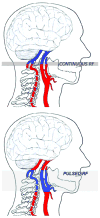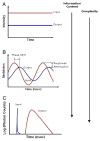Noninvasive cerebral perfusion imaging in high-risk neonates
- PMID: 20109972
- PMCID: PMC2829712
- DOI: 10.1053/j.semperi.2009.10.005
Noninvasive cerebral perfusion imaging in high-risk neonates
Abstract
Advances in medical and surgical care of the high-risk neonate have led to increased survival. A significant number of these neonates suffer from neurodevelopmental delays and failure in school. The focus of clinical research has shifted to understanding events contributing to neurological morbidity in these patients. Assessing changes in cerebral oxygenation and regulation of cerebral blood flow (CBF) is important in evaluating the status of the central nervous system. Traditional CBF imaging methods fail for both ethical and logistical reasons. Optical near infrared spectroscopy (NIRS) is increasingly being used for bedside monitoring of cerebral oxygenation and blood volume in both very low birth weight infants and neonates with congenital heart disease. Although trends in CBF may be inferred from changes in cerebral oxygenation and/or blood volume, NIRS does not allow a direct measure of CBF in these populations. Two relatively new modalities, arterial spin-labeled perfusion magnetic resonance imaging and optical diffuse correlation spectroscopy, provide direct, noninvasive measures of cerebral perfusion suitable for the high-risk neonates. Herein we discuss the instrumentation, applications, and limitations of these noninvasive imaging techniques for measuring and/or monitoring CBF.
(c) 2010 Elsevier Inc. All rights reserved.
Figures









References
-
- Back SA, Riddle A, McClure MM. Maturation-dependent vulnerability of perinatal white matter in premature birth. Stroke. 2007;38:724–730. - PubMed
-
- Rezaie P, Dean A. Periventricular leukomalacia, inflammation and white matter lesions within the developing nervous system. Neuropathology. 2002;22:106–132. - PubMed
Publication types
MeSH terms
Substances
Grants and funding
LinkOut - more resources
Full Text Sources
Medical

